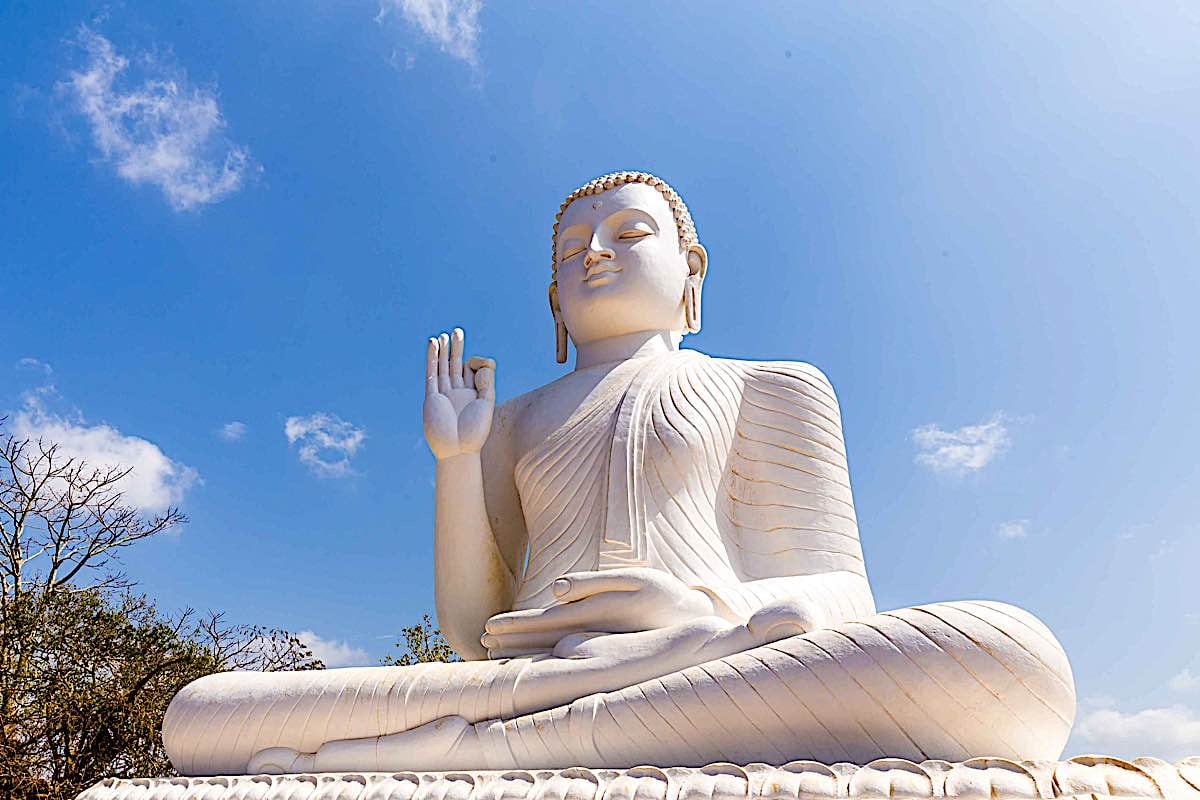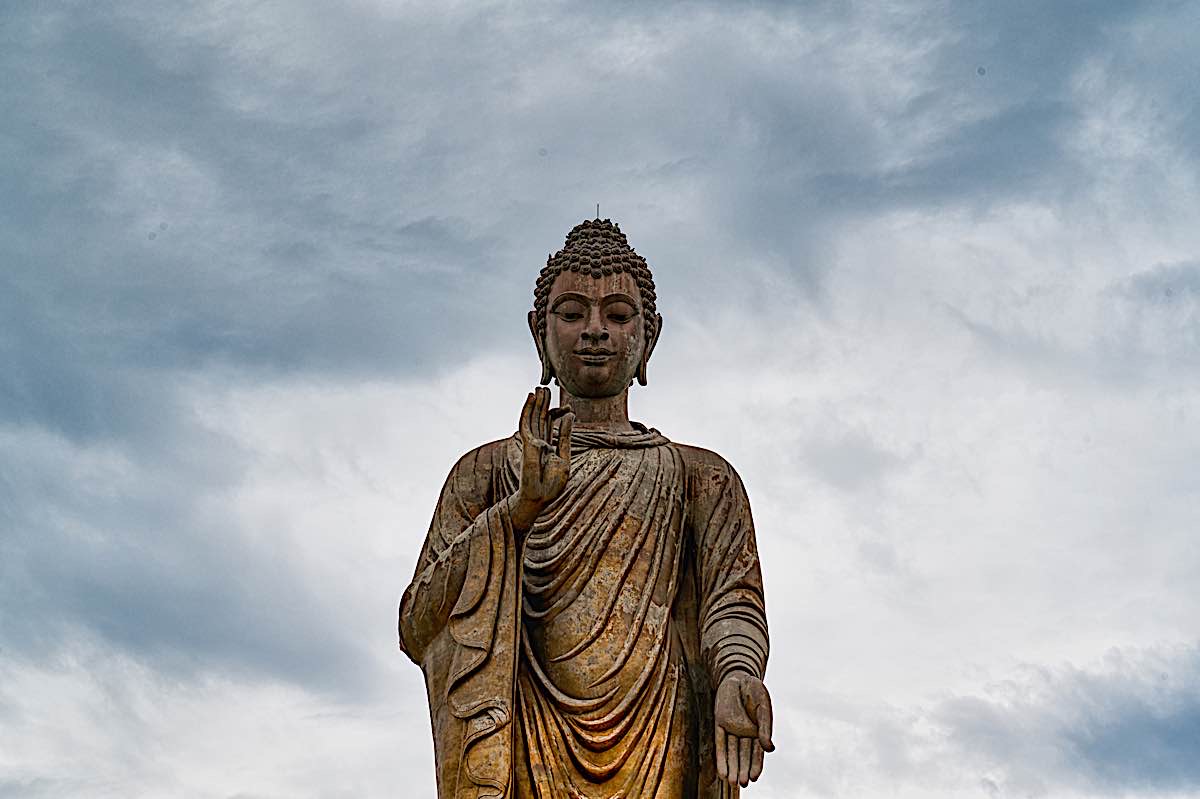Transform your life with the four protective meditations taught in Buddhism
Today’s modern world can leave you spinning. Finding time to look inward is challenging with all the external stimuli demanding your attention. However, the human soul cries out for the deeper understanding and peace that only contemplative practices can...

Today’s modern world can leave you spinning. Finding time to look inward is challenging with all the external stimuli demanding your attention. However, the human soul cries out for the deeper understanding and peace that only contemplative practices can bring, such as the four protective meditations in Buddhism.
By Beth Rush,
Editor, Body Mind>>
Time spent in meditation allows you to connect to the energies and mysteries connecting all living beings. To walk the Eightfold Path, you must practice the Four Noble Truths. What are the four types of meditation in Buddhism and how can you use them to transform your life?
 The giant statue of Buddha at Wat Thipsukhontharam in Thailand. Buddha holds his hand up in the Abhaya or fearless mudra, symbolizing the protection of Buddhist practices.
The giant statue of Buddha at Wat Thipsukhontharam in Thailand. Buddha holds his hand up in the Abhaya or fearless mudra, symbolizing the protection of Buddhist practices.
What are the four protective meditations?
The four protective meditations in Buddhism help to reframe your mindset. You might use them in preparation for a longer sitting meditation session or as individual subjects to study deeply. What are these and what is the specific intent of each?
1. Recollection of the Buddha
Recollection of the Buddha is an excellent protective meditation when you have a long and arduous journey. It’s also beneficial when you feel stuck, disappointed, listless and dissatisfied with your progress.
 Buddha’s life example — as expressed in many sutras and suttas — focus especially on the importance of impermanence and meditation on death. By focusing on death, sickness, old age and suffering, our practice is motivated with a sense of urgency. Analyzing the causes led to Buddha’s glorious teaching on the Eightfold Path (see below.) In this image, in a temple in Cambodia, we see Buddha in his chariot venturing out and encountering a dead person, a sick person, and old person and a holy person. These sights inspired his quest for Enlightenment.
Buddha’s life example — as expressed in many sutras and suttas — focus especially on the importance of impermanence and meditation on death. By focusing on death, sickness, old age and suffering, our practice is motivated with a sense of urgency. Analyzing the causes led to Buddha’s glorious teaching on the Eightfold Path (see below.) In this image, in a temple in Cambodia, we see Buddha in his chariot venturing out and encountering a dead person, a sick person, and old person and a holy person. These sights inspired his quest for Enlightenment.
This meditation can bridge the gap between spiritual practice and modern therapeutic techniques. For example, it may comfort people in recovery from substance abuse by reminding them they will face triggers and setbacks, just as the Buddha faced hardships and outside distractions on his path to enlightenment. His journey was not short nor easy — by emulating his example, you, too, can persevere.
Studying sutra, reciting sutra and meditating on the Buddha’s life are way to engage in “Recollection of the Buddha.” For a feature on the importance or reciting sutra on Buddha Weekly, see>> Meditation on loving kindness has 10 health and wellness benefits according to peer-reviewed studies. For a feature covering this peer-reviewed research on Metta, see>>
Meditation on loving kindness has 10 health and wellness benefits according to peer-reviewed studies. For a feature covering this peer-reviewed research on Metta, see>>
2. Metta meditation
Metta is loving-kindness, which serves as an antidote to anger and ill-will, one of the five hindrances. It’s particularly helpful in today’s world, where opposing viewpoints often meet with hostility instead of a sober and curious examination of the deeper issues.
Metta meditation helps you unearth the seed of your anger. Usually, you direct your energy to an outside party, laying the blame at their feet for the suffering this emotion causes you. Metta meditation reminds you your inner experience belongs to you and you ultimately decide how to respond to that emotion. You recall that others have similar internal landscapes and feel inspired to offer them the same compassion and desire for understanding you want to receive from them.
For a video feature on Metta meditation on Buddha Weekly, see>> In sweeping meditation is also called “scanning” our bodies and observing our bodies. This meditation should be undertaking without judgment or analysis.
In sweeping meditation is also called “scanning” our bodies and observing our bodies. This meditation should be undertaking without judgment or analysis.
3. Contemplation of the Body
Contemplation of the body seeks to remove sensual desire and lust. However, in modern times, it can also help you find peace and acceptance of who you are. Reducing the body to parts and systems lets you recognize the transience of physical attractiveness while also building a deeper appreciation for the marvel of life. How glorious is it that your cells perform such radically different functions, yet all harmonize to create the mystery of you?
 Buddha passed peacefully into paranirvana — with no fear. He understood and taught that everything is impermanent.
Buddha passed peacefully into paranirvana — with no fear. He understood and taught that everything is impermanent.
4. Reflection on Death
Reflection on death — meditations on impermanence — helps you overcome idleness. When you remember your time is finite, you understand the need for diligence. You gain a deeper appreciation of mindfulness practices for keeping you balanced in the present and helping you fully experience each moment of this incarnation.
For a feature “Learning How to Die” on the importance of reflections on death and impermanence on Buddha Weekly, see>>Four protective meditations in Buddhism?
Although you can use the four protective meditations alone, you can also direct your intent with each. Buddhist meditation may occur when sitting on your zafu or in walking meditation. However, you should know the four types of meditation in Buddhism to concentrate your mental energies.
 Many statues of Buddha feature the Abhaya Mudra, the hand held up in a protective mudra gesture.
Many statues of Buddha feature the Abhaya Mudra, the hand held up in a protective mudra gesture.
1. Concentrative
These practices help you regain focus when your mental energies are scattered everywhere. Mindfulness of breathing is a classic example.
For a full feature on Samatha (with video) mindfulness of breathing meditation on Buddha Weekly, see>>2. Generative
Generative meditations direct your attention to what you want to manifest more of in this life. For example, many people who use guided meditations engage in this practice, even if they do not identify as Buddhists.
3. Receptive
Sensory receptive meditations open you to the mindfulness of the present moment. It also allows you to recognize your present experience. For example, performing a body scan tunes you into the physical sensations affecting you outside of your ordinary awareness.
For a feature on mindfulness of each moment on Buddha Weekly, see>>4. Reflective
Reflective meditations help you integrate your outside experiences with your internal schema or worldview. For example, seeking to understand the roots of your anger and suffering would be a type of reflective meditation.
For a feature on advanced Mahamudra analytical or reflective meditation and Vipassana (including a video teaching) see>>Practice Buddhist protective meditations to change your life
If you hope to transform your life, your journey begins within. Contemplating the four protective meditations in Buddhism can become a powerful part of your path.
Feature by Beth Rush,
Editor, Body Mind>>
 Beth Rush, Editor Body Mind.
Beth Rush, Editor Body Mind.Beth Rush is the Managing Editor and content manager at Body+Mind. She is a well-respected writer in the personal wellness space and shares knowledge on a variety of topics related to nutrition, holistic health, and mental health. You can find Beth on Twitter @bodymindmag.

 Astrong
Astrong 
































